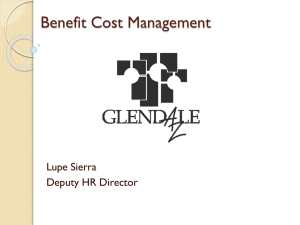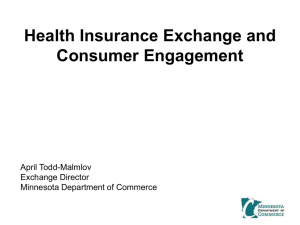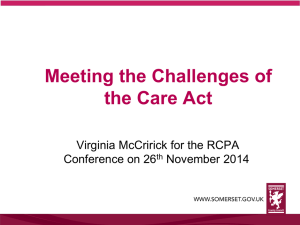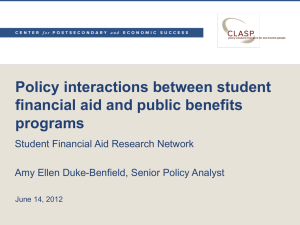Changes in the Health Care Reform Bill
advertisement
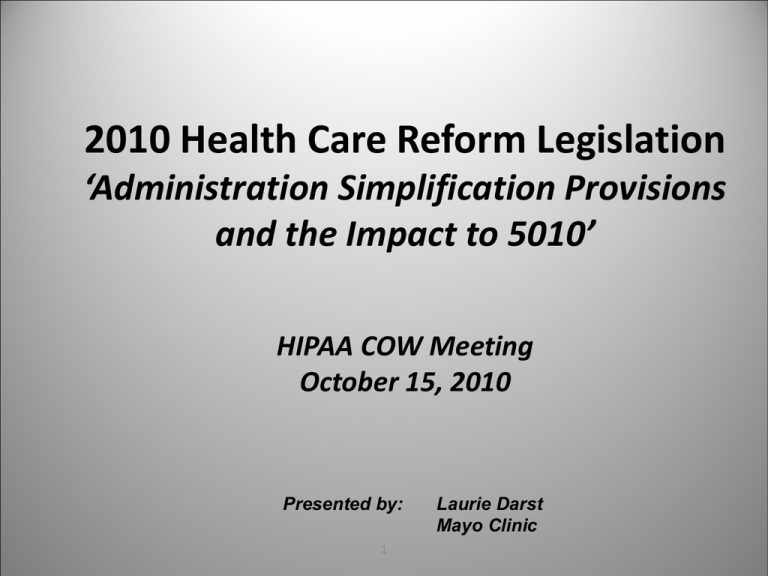
2010 Health Care Reform Legislation
‘Administration Simplification Provisions
and the Impact to 5010’
HIPAA COW Meeting
October 15, 2010
Presented by:
1
Laurie Darst
Mayo Clinic
Administrative Simplification
• Patient Protection and Affordability Act (PPACA) –
H.R. 3590 – now referred to as Affordable Care Act
(ACA)
• Administrative Provisions identified in two sections of
health care reform bill
– Section 1104 – Administrative Simplification
– Section 10109 – Development of Standards for
Financial and Administrative Transactions
• Significant Changes to the HIPAA requirements
• Allows for adoption of standards and operating rules
via Interim Final Rules, eliminating the need for
NPRMs
2
Operating Rules
• New Concept of Operating Rules
– are defined as “the necessary business rules and guidelines for the
electronic exchange of information that are not defined by a standard or
its implementation specifications as adopted”
• Requires that standards and operating rules
– “to the extent feasible and appropriate, enable determination of an
individual’s eligibility and financial responsibility for specific services
prior to or at the point of care;”
and
– “provide for timely acknowledgment, response, and status reporting
that supports a transparent claims and denial management process
(including adjudication and appeals)”
• Operating Rules to be developed by a non-profit entity meeting
specific conditions
3
Operating Rules
• Operating Rules – Implementation
– HHS required to adopt operating rules, based on recommendations from
developer of rules, NCVHS and consultation with providers
– Eligibility and Claims status
• July 1, 2011 – adoption of operating rules
• January 1, 2013 – effective date of operating rules
– EFT, Claims payment / remittance advices
• July 1, 2012 – adoption of operating rules
• January 1, 2014 – effective date of operating rules
– Health Claims, health plan enrollment / disenrollment, health plan
premium payment, referral certification and authorization
• July 1, 2014 – adoption of operating rules
• January 1, 2016 – effective date of operating rules
– HHS may use expedite rulemaking (interim final rule with 60 day
comment)
4
Requirements to Adopt Standards
• HHS to adopt:
– National Plan ID to be effective not later than Oct
1, 2012
– an EFT standard, to be adopted no later than Jan
1, 2012 and effective not later than Jan 1, 2014
– a claims attachment standard and set of
operating rules, to be adopted no later than Jan 1,
2014 and effective not later than Jan 1, 2016
5
Periodic Updating of Standards and
Operating Rules
• Beginning April 1, 2014 review committee will meet
and recommend updates.
• Committee to meet not less than every two years
after that
• Recommendations for updates to be adopted by an
interim final rule not later than 90 days after receipt
of the committee’s report.
6
Certification Requirements and New
Penalties for Health Plans
• Health Plan Certification Requirements
– Health plans must file certification statement with HHS attesting they are
compliant with standards and operating rules
– Health plans must extend requirements to business associates (BAA),
BAA must certify that they are compliant
– Certification statement must be accompanied by evidence of compliance
and end to end testing with trading partners.
• Penalties for Not Certifying
– $1 per covered life per day not certified up to a max of $20 per covered
life per year
– Double penalties if false statements submitted
7
Timelines
Topic
Regulation Date
Effective (implementation) date
Operating rules for eligibility and
claims status
Operating rules for remittance advice
and EFT
July 1, 2011
July 1, 2012
Jan 1, 2013 (one year after 5010, 9
months before ICD-10)
Jan 1, 2014
Operating rules for claims, enrollment
and disenrollment, premium
payments, and referrals
July 1, 2014
Jan 1, 2016
Final Rule for Unique Health Plan
Identifier
ASAP
October 1, 2012
Standard for Electronic Funds Transfer
Jan 1, 2012
Standard and Operating Rules for
Claims Attachment
Jan 1, 2014
Jan 1, 2014 (same date for operating
rule)
Jan 1, 2016
Health plans file statement that their
systems are in compliance with
standards and operating rules for EFT,
eligibility, claims status, and payment
and remittance advice.
Dec 31, 2013
8
Timelines
Topic
Regulation Date
Effective (implementation) date
Health plans file statement that their
systems are in compliance with
standards and operating rules for
claims, enrollment and disenrollment,
premium payments, claims
attachments, and referral
certification/authorization.
Dec 31, 2015
NCVHS or another committee holds
hearings every two years to discuss
and recommend changes to standards
and operating rules
Changes to standards that are
recommended by the committee
April 1, 2014 and every two years
thereafter
90 days after Secretary receives
committee report
Penalty Fees
9
27 months after regulation
publication. (60 day comment period
plus 25 months for implementation)
No later than April 1, 2014.
Operating Rules
What We Know:
• Operating rules defined as
“necessary business rules”
• Adoption and Effective
Dates Established
What We Don’t Know
• Definition of “necessary
business rules”
• The entity(s) who will
develop operating rules
• How Operating Rules and
the Standards will be
coordinated
• What changes will be
needed to 5010 as result of
Operating Rules
– Eligibility & Claim Status
Effective Date Jan 1, 2013
• Rulemaking process may be
expedited
10
Operating Rules – NCVHS
Recommendations to HHS
Operating Rules
Recommendations
Recommendations:
•
•
Entities recommended are only for
the eligibility and claim status
transactions at this time
Recommend CAQH CORE develop the
operating rules to support the ANS
X12 270/271 and 276/277
transactions
–
•
•
•
• Performance and system
availability requirements
• Connectivity and transport
requirements
• Security and authentication
requirements
• Business scenarios and expected
responses
• Data content refinements (to
situational data elements and
codes used with specific data
elements
Adopt CORE Phase I and Phase II operating
rules
Pharmacy related operating rules
continue to be defined by NCPDP
Changes to content of a standard’s
implementation guide must be
evaluated by the DSMO
Allow only limited use of companion
guides
11
National Health Plan Identifier
What We Know:
• Final Rule Expected to be
released “soon”
• Effective Date for NHPI is
October 1, 2012
What We Don’t Know:
• What is the purpose of the
NHPI
• What will it look like
• NHPI granularity
• Who will be the enumerator
• Will the NHPI
implementation impact the
different 5010 transactions
12
High Level Summary of Other
Recommendations to NCVHS
• Stakeholders from all sectors of the industry
provided testimony at the July 19, 2010
NCHVS Hearing
• General Agreement
• Division of opinion
– No agreement could be reached on HPID purpose
(business use cases) and the level of granularity
needed
– Definition of health plans under HPID
13
Other Recommendations to NCVHS
General Agreement
• Identification of the recipient of a transaction
• Pharmacy current method of identifying
payers is working. Any changes to this process
should be vetted through the pharmacy
industry
• Grandfather provision for entities having ISO
U.S. Healthcare Identifiers assigned prior to
the availability of the HPID
• Industry has concerns about the date and the
ability to fully implement by October 2012
14
Other Recommendations to NCVHS
Definition of Health Plans- Division of Opinion
• Definition of health plans
– Some felt only entities defined by HIPAA statute
should be defined as “health plans” for the
purpose of assigning HPID
– Others felt the definition should include
administrators, contractors, networks, repricers,
property and casualty insurers, subrogation firms,
and others to support the business use cases
15
Other Recommendations to NCVHS
Levels of Enumeration - Division of Opinion
• Levels of Enumeration
– Some felt there should be no HPID enumeration
hierarchy established
– Others felt there be the following enumeration
hierarchy:
• HPID Type 1 {Parent}
• HPID Type 2 {Subpart(s)}
16
Other Recommendations to NCVHS
Purpose (Use Cases)- Division of Opinion
Perspective I
• Purpose(s) or business use cases of HPID:
– Identify entities that fall into the definition for
administering the standard transactions.
– Payers would identify the need for additional
enumeration based on the health plans’ business
needs as related to the transactions
• Other data needs can and should be
addressed through the standards and
operating rules in the same time frame as
HPID
17
Other Recommendations to NCVHS
Purpose (Use Cases)- Division of Opinion
Perspective II
• In addition to utilizing the HPID for the routing of
transactions, the HPID could address a number of
existing challenges impacting the provider community
• These challenges are a result of increased
complexities due to the numerous entities serving in
health plan roles
• Discrete data (i.e. HPID) was needed versus free-form
text fields already available in the transaction
standard to successfully address these issues
18
Other Recommendations to NCVHS
Purpose (Use Cases)- Division of Opinion
Perspective II
• At time of registration, the appropriate entities need to be
identified so expectations of the payer/provider relationship
can be handled appropriately before the services are provided
(out-of-network determination and payment expectations)
(referral and authorization criteria)
– Information sent back to providers in the Eligibility transaction only
reflect a patient’s global benefit information, it does not reflect patient
benefits specific to the requesting provider (benefit information is not
provided regarding the provider/payer contractual relationship)
– If enumerated beyond routing of the transactions, there could be a
reduction in phone calls and better management of patient
expectations
19
Other Recommendations to NCVHS
Purpose (Use Cases)- Division of Opinion
Perspective II
• The enumeration of these entities would also
be returned in the remit so the payment
posting process can be automated and the
appropriate contractual amounts applied
20
Other Recommendations to NCVHS
Purpose (Use Cases)- Division of Opinion
Perspective II
• Enumerate each of the discrete attributes of the complex
third-party payment process to facilitate automation (focus on
eligibility and remit transactions)
– Entity responsible for receiving the claim (eligibility only)
– Entity responsible for administering the claim (eligibility & remit)
– Plan/product description (must be synched with 835) (eligibility &
remit)
– Entity that has the direct contract with the provider (eligibility & remit)
– Fee schedule that applies to the claim (eligibility & remit)*
– Entity responsible for funding the benefit (eligibility only)
21
Other Recommendations to NCVHS
Purpose (Use Cases)- Division of Opinion
Perspective I and Perspective II
Discussion between the two perspective groups revealed:
• Perspective I respondents did not support the use of HPID as a
solution for other administrative challenges. However, they did
acknowledge the challenges outlined were a concern, but
recommended the use of the standard transactions and
operating rules as a potential solution
• Perspective II respondents did not feel the standard
transactions and operating rules would address these issues
adequately due to the need for discrete information and a
number of other factors
22
National Health Plan Identifier– NCVHS
Recommendations to HHS
• HHS should:
– Clarify definition of health plan
– Work with stakeholders to reach consensus on
names and definition for intermediary entities
– Request stakeholders work with groups such as
WEDI, AHIP, NAIC, DSMO for definition of products
to be used in plan enumeration by October 31,
2010
– Coordinate with other aspects of the ACA
National Health Plan Identifier– NCVHS
Recommendations to HHS
• HHS should:
– Initially enumerate all health plan legal entities as
defined in HIPAA legislation
– Determine at what level, including product
(benefit package) level should also be enumerated
– Adopt HPID that follows ISO Standard 7812 with
Luhn check-digit
– Adopt an HPID that contains no embedded
intelligence
National Health Plan Identifier– NCVHS
Recommendations to HHS
• HHS should:
– Establish an HPID enumeration system and process to
support a robust online directory database
• Related to Pharmacy
– Not require the HPID to be used in place of exiting
RxBIN/PCN
• Consider effective date of October 2012 be interpreted
as date to begin registering for an HPID
– October 1, 2012 – March 31, 2013: Enumeration
– April 1, 2012 – September 30, 2013: Testing
– October 1, 2013: Implementation
NCVHS Recommendations to HHS
• Keep in mind:
– NCHVS is an advisory body to HHS, but the
information listed on the previous slides should be
considered only recommendations to HHS for
Operating Rules and HPID
• HHS will publish the mandated requirements
in a Interim Final Rule by next summer
Stay tuned…..
National Health Plan Identifier
High Level Analysis from X12
ASC X12 Summary Level Analysis:
• NPHI is accommodated in all of the ASC X12
transactions
• NHPI occurs 30 times in the 005010 version
• It is referenced 19 times in situational rules or
segment and data element notes
• This does not account for any trading partner use of
NHPI within the transaction envelopes
Input provided by ASC X12 (July 2010)
27
National Health Plan Identifier
High Level Analysis from X12
ASC X12 Implementation Highlight:
• 837 Claim Transaction
– The Claim Filing Indicator (SBR09) is no longer
allowed one the NHPI is mandated.
– This field is used today in front end edit routines
– May be impact to the level of NHPI granularity
needed
28
Input provided by ASC X12 (July 2010)
National Health Plan Identifier
High Level Analysis from X12
ASC X12 Implementation Highlight:
• 271 Eligibility Transaction
– Both the Subscriber Benefit Related Entity (Loop
2120C) and the Dependent Benefit Related Entity
(Loop 2120D) require the use of the NHPI when the
benefit related entity is a payer. This would occur
when the benefit related entity is a different payer
than that identified as the Information Source or
when the Information Source is an entity other than a
payer.
29
Input provided by ASC X12 (July 2010)
Questions & Discussion
LAURIE DARST
MAYO CLINIC
DARST.LAURA@MAYO.EDU
(507) 266-3054
30

